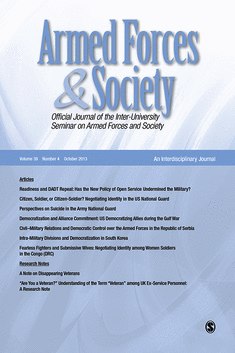Armed Forces & Society
 | |
| Discipline | Sociology, political science |
|---|---|
| Language | English |
| Edited by | Patricia M. Shields |
| Publication details | |
| History | 1974–present |
| Publisher | |
| Frequency | Quarterly |
| 0.591 (2014) | |
| Standard abbreviations | |
| ISO 4 | Armed Forces Soc. |
| Indexing | |
| ISSN | 0095-327X (print) 1556-0848 (web) |
| LCCN | 74648333 |
| OCLC no. | 01796471 |
| Links | |
Armed Forces & Society is a quarterly peer-reviewed academic publication that publishes scholarly articles and book reviews on political science, civil–military relations, military sociology, military psychology, military institutions, conflict management, arms control, peacekeeping, conflict resolution, military contracting, terrorism, and military ethics. It is the official publication of the Inter-University Seminar on Armed Forces and Society and published by SAGE Publications. The current editor-in-chief is Patricia M. Shields (Texas State University).
Armed Forces & Society was established in 1974 by Morris Janowitz (University of Chicago) and became the "first professional journal to focus on the connection between the military and society in an international and interdisciplinary way."[1] It covers a variety of topics, from Dutch peacekeeping missions, to gender-military and veterans issues. Furthermore, the journal attempts to include a broad focus on "larger theoretical and policy connections," which emphasize questions about the role of the military in sustaining democratic values.[1]
Scholarly studies of Armed Forces & Society
Armed Forces & Society has been the subject of multiple scholarly publications. Ender (2001) examined the characteristics of the journal's first 25 volumes, exploring such factors as academic, regional, and institutional affiliation, as well as co-authorship and the gender configuration of co-authors.[2] Camacho and Atwood (2007) reviewed publications in Armed Forces & Society between 1974 and 2006 regarding veterans and proposed new research projects on the subject.[3]
The journal has also been the subject of study by graduate students in the MPA program at Texas State University. Olldahsi (2002) examined civil-military relations within emerging democracies, as treated in twenty key articles on the subject, and concluded that institutional structures were emphasized, but that there is more room for theoretical scholarship on the subject.[4] Sexton (2003) established descriptive categories for 117 articles between 1998 and 2003, using Seibold's military sociology as a framework for issue categories.[5] Bowman (2005) conducted a descriptive study of manuscripts and reviewers for the journal, utilizing content analysis and archival records analysis.[6] Brady (2010) reviewed articles from the journal between 1974 and 2009 with a focus on peacekeeping issues and found that most peacekeeping articles related to personnel administration among peacekeeping forces. Brady's study concluded that there is a potential for greater publication on the wider political and military context in which peacekeeping missions take place.[7]
Impact
According to the Journal Citation Reports, Armed Forces & Society has a 2014 impact factor of 0.591, ranking it 96 out of 161 journals in the category "Political Science" and 94 out of 142 journals in the category "Sociology".[8]
According to Google Scholar, Armed Forces & Society is ranked 12th among the Top 20 Military Studies publications.[9]
Former Editors
The following persons have been Editor-in-Chief of the journal:
- Morris Janowitz (1973-1983)
- David R. Segal (1983-1989)
- Claude Welch (1989-1992)
- Jay Stanley (1992-1995)
- James Burk (1995-1998)
- Mark Eitelberg (1998-2001)
- Patricia M. Shields (2001–Present)
The following persons have been Book Review Editors of the journal:
- William Ruger (2007-2015)
- Jeremy Teigen (2008-Present)
The following persons have been Editorial Assistants for the journal:
- Travis Whetsel (2010-2012)
- Colin Smith (2012-2014)
- Chad Kunsman (2014-Present)
See also
- Journal of Peace Research
- Parameters
- Naval War College Review
- Journal of Conflict Resolution
- International Security
- Security Studies (journal)
- Military Review
References
- ^ a b Armed Forces & Society, InCites, Thomson Reuters, May 2005. Accessed 12 May 2011
- ^ Ender, Morten G. (2001). "Authorship and Affiliation in Armed Forces & Society: Volumes 1-25". Armed Forces & Society. 27 (4): 623–38. doi:10.1177/0095327X0102700406. Retrieved 12 May 2007.
- ^ Camacho, Paul R., and Paul L. Atwood (2007). "A Review of the Literature on Veterans Published in Armed Forces & Society, 1974-2006". Armed Forces & Society. 33 (3): 351–81. doi:10.1177/0095327X06297241. Retrieved 12 May 2007.
{{cite journal}}: CS1 maint: multiple names: authors list (link) - ^ Olldashi, Arjana (2002). "Civil-Military Relations in Emerging Democracies as Found in the Articles of Armed Forces & Society" (PDF). Texas State University. Retrieved 12 May 2007.
{{cite journal}}: Cite journal requires|journal=(help) - ^ Sexton, Nathan (2003). "A Description of the Articles of the Past Five Years of Armed Forces & Society" (PDF). Texas State University. Retrieved 12 May 2007.
{{cite journal}}: Cite journal requires|journal=(help) - ^ Bowman, Anthony (2005). "A Descriptive Study of Manuscripts and Reviewers for the Armed Forces & Society Journal" (PDF). Texas State University. Retrieved 12 May 2007.
{{cite journal}}: Cite journal requires|journal=(help) - ^ Brady, Chris (2010). A content analysis of peacekeeping issues for the journal Armed Forces & Society. Texas State University. ecommons - http://ecommons.txstate.edu/arp/334/
- ^ "Journals Ranked by Impact: Political Science and Sociology". 2014 Journal Citation Reports. Web of Science (Social Sciences ed.). Thomson Reuters. 2015.
- ^ "Top 20 military Studies publications". Google Scholar.
